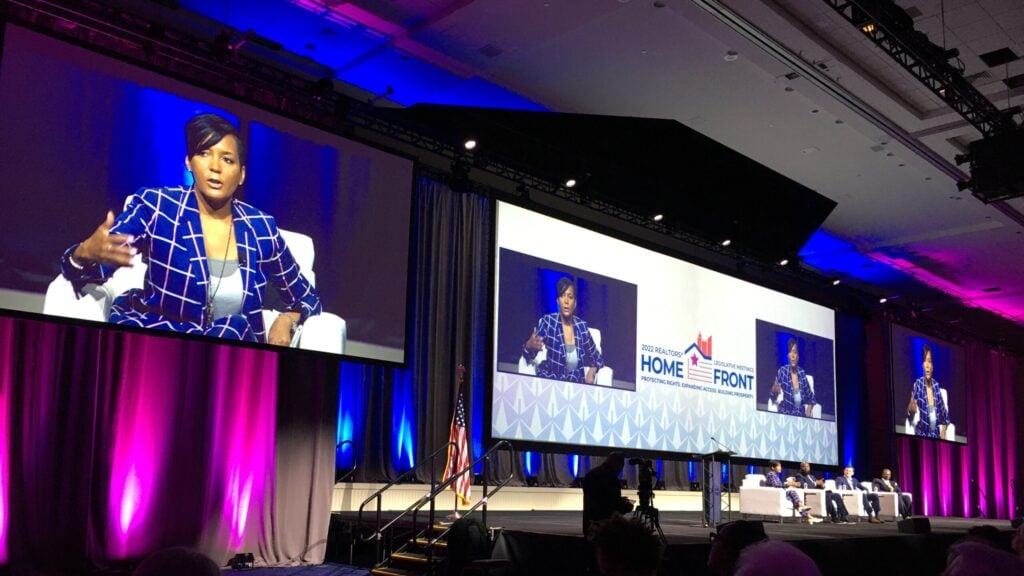The National Association of Realtors’ midyear conference is kicking off with an emphasis on fair housing and what it means for the economy and the nation.
The 1.5-million-member trade group’s Realtors Legislative Meetings are back in Washington D.C. this year, after being held virtually for the past two years. Hundreds gathered Monday morning at the event’s Federal Legislative and Political Forum, which was called “Building Prosperity Through Fair Housing” and featured former Atlanta mayor Keisha Lance Bottoms and former Trump advisor Ja’Ron Smith.
This afternoon there will be additional event sessions related to fair housing, including “Our Racial Moment of Truth: The Infrastructure of Our Divisions and its Impact on Housing Policy,” featuring “The Warmth of Other Suns” and “Caste” author Isabel Wilkerson, and “Addressing Bias in the Appraisal Process,” featuring Melody Taylor, executive director of the Biden Administration’s Interagency Task Force on Property Appraisal and Valuation Equity (PAVE).
Ennis Antoine, a managing broker at Compass, started off this morning’s forum announcing NAR’s goal of adding three million net new Black homeowners by 2030. The goal, called the 3by30 initiative, was set by the Black Homeownership Collaborative, of which NAR is a founding member.
The current homeownership rate for black households stands at 43 percent, compared to 72 percent for white households. The initiative’s website says black homeownership would have to rise by about 5 million net new homeowners to reach the white homeownership rate. The current goal represents an increase of more than 10 percentage points to the black homeownership rate, according to the site.
In their remarks, Smith and Lance Bottoms pointed to the difficulties of achieving homeownership when living paycheck to paycheck due to high rental costs, high student loan debt, high childcare costs, and the lack of a living wage for those who do not complete a college education.
“When you think about all the complexities around homeownership, you have to first think about where people start and many people can’t afford to kind of live month to month, let alone buy a house,” Smith said. “I experienced that personally.”
While his own father bought a home when he was around 25 years old, Smith (who was born in 1982) was nearly 40 when he bought his first home.
“What does that say about who we are as a nation?” Smith said.
“It’s harder for individuals to achieve that American dream, to have that home, to have the two cars, to have a safe and secure neighborhood, and have great schools. So that puts us in a position to try to solve for these nuances now that we’re in the 21st century.”
Lance Bottoms pointed to appraisal bias, noting that her family had recently had a second home appraised and she was “stunned that the appraisal came in much lower than I anticipated.”
She admitted that her expectation of the home’s value came from Zillow’s Zestimate and she didn’t know how accurate that was, prompting some groans and some laughter from the audience.
“But I couldn’t help but wonder when I saw the appraisal come in significantly lower was it because we had African American art up in the house?” she said.
“I don’t know if it’s accurate or not, but the fact that I have to wonder that I think really speaks to the challenges that we still have in this area.”
She later got applause when she told the audience, “My mother is a Realtor.”
Smith and Lance Bottoms urged Realtors to use their well-known advocacy prowess to push for local, state and nation changes, such as teaching financial literacy in schools, educating prospective homeowners about the costs of homeownership, taking rental and utility payments into account for credit scoring, changing zoning to allow the building of more housing, and incentivizing the building of additional housing units.
“You guys can help us do it,” Smith said.
Lance Bottoms said, “Advocacy is extremely important. You are on the ground and know what the challenges are. Policy changes come from people saying, ‘This is what I see as an issue.’”
NAR is important because “elected officials will come and go,” she added. “You are a constant.”
She encouraged Realtors to become what she called “the t-shirt people.” She said when she was mayor she would see the same people come to city hall, but they would dress in a different t-shirt depending on what their issue was.
“Their voices were heard because they made their presence known,” she said.
“When you show up in numbers, whether it’s through emails, whether it’s through showing up physically, it makes a difference to how we approach policy when we know that there are voices and bodies behind what we need to push.”
Antoine pointed out that some people argue that “we shouldn’t focus on the difference between races” and bring attention to the white-black homeownership gap.
“Well, to the extent that it’s not an issue anymore then we can stop discussing it,” Lance Bottoms said, prompting applause and some laughter.
“I don’t think anybody wants to have to discuss it.”
She pointed to a national fair housing report that detailed 3.7 million instances of racial discrimination in housing and noted that housing discrimination used to be overt before the Fair Housing Act.
“[It’s] discrimination with a smile now, so it’s in these things that we always don’t see,” she said. “It may be in the lower appraisal. It may be when someone with a name like Keisha or Ja’Ron calls about a housing unit and we’re told that there aren’t any units available.”
What’s most concerning, she said, is that in order for a discrimination investigation to be initiated, someone has to make a complaint.
“So you often have someone who’s already dealing with life issues, who knows that they’ve been discriminated against and then they have to take that extra step to file a complaint to create an investigation,” she said.
“We can stop talking about discrimination when we can stop dealing with discrimination. But based on these facts, it’s still very real and still a very necessary discussion.”
Smith agreed and pointed to redlining, racial covenants and other policies that created the black-white wealth gap.
“The only way we can solve for it is being very intentional about solving for the issue that existed before many of us were in a position of power,” he said.
“And now that we know the history, let’s figure out some solutions that will help everyone. Overall, of course you want to create housing policy that helps all Americans.”
Poverty isn’t a racial issue “all the time,” he said. It touches everyone.
“But we do have to account for some of the racial policies that were put in place that created this big disparity between black and white,” he added.
“We can solve for all of these issues at the same time by having one solution, but you can’t really run from the fact that [the racial policies] existed and I think owning up to will allow for us to position ourselves to find solutions.” The crowd applauded.
Moderator Keith Henley, broker-owner at RE/MAX Elite, noted that the Federal Reserve, Morgan Stanley and Citigroup have all done research showing that housing discrimination shrinks the economy. “Do you think the economic growth argument could be persuasive to those who might be opposed to targeting our homeownership efforts for groups that have faced historic and present-day discrimination?” he asked.
Smith replied, “That answer to that question is yes. Growth, especially for Republicans, really moves the needle because we want to continue to be competitive on the world stage. But it also speaks to the fact that if we create an equal system of opportunity that helps everyone makes us a stronger nation.”
He added, “We need to create situations where more people can own homes, or have that ability. Why? Because that passes on to the next generation.”
Stability in housing affects everything, according to Lance Bottoms.
“Mortality rates, access to good food, access to healthcare,” she said. “Not very far from my community, there is a 10-year life expectancy difference between one community, we call it Bankhead, and [another] Buckhead … in the same city.”
She spoke about her niece who just bought a home a 50-minute drive from her job in Atlanta because her home offers kept getting rejected.
“That impacts our economy,” Lance Bottoms said.
One audience member, Amy McCoy of Atlanta, pointed out that Atlanta has a majority-minority population but its black homeownership rate is only 32 percent compared to 70 percent for white Americans.
“Do you believe the best way to close this racial and wealth gap is to now transfer wealth?” she asked.
Lance Bottoms said, “No.”
“I think that we have to allow people and give people the opportunities to build wealth,” she said.
“When you start using terms like ‘transferring wealth,’ it’s a nonstarter for conversation for a lot of people and I don’t think it gets us very far. I think if you speak in terms of helping people to build wealth, that’s a much more productive conversation.”
The audience clapped. Smith agreed with Lance Bottoms.
Email Andrea V. Brambila.
Like me on Facebook | Follow me on Twitter



 Are You Interested in West Eleventh Residences Miami?
Are You Interested in West Eleventh Residences Miami? Are You Interested in ONE Park Tower by Turnberry?
Are You Interested in ONE Park Tower by Turnberry? Are You Interested in Diesel Wynwood Condominium?
Are You Interested in Diesel Wynwood Condominium? Are You Interested in Five Park Miami Beach?
Are You Interested in Five Park Miami Beach? Are You Interested in Cipriani Residences Miami?
Are You Interested in Cipriani Residences Miami? Are You Interested in Bentley Residences Miami?
Are You Interested in Bentley Residences Miami? Are You Interested in Baccarat Residences Brickell?
Are You Interested in Baccarat Residences Brickell? Are You Interested in Aria Reserve Miami?
Are You Interested in Aria Reserve Miami? Are You Interested in 888 Brickell Dolce & Gabbana | Miami?
Are You Interested in 888 Brickell Dolce & Gabbana | Miami? Are You Interested in 600 Miami WorldCenter?
Are You Interested in 600 Miami WorldCenter? Are You Interested in HUB MIAMI RESIDENCES?
Are You Interested in HUB MIAMI RESIDENCES? Are You Interested in WALDORF ASTORIA RESIDENCES?
Are You Interested in WALDORF ASTORIA RESIDENCES?